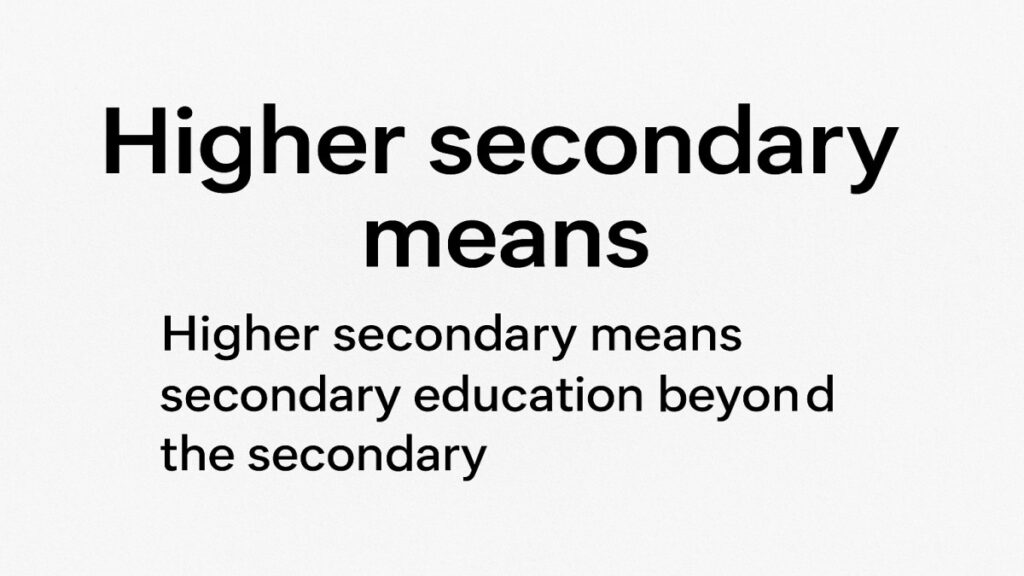Introduction
Higher Secondary Mean. Ever wondered what “Higher Secondary” actually means? You’re not alone. It’s one of those educational terms that pops up all the time especially on school forms and exam reports but its meaning can change based on where you are in the world. Let’s clear that up once and for all.
Educational Structure Overview
Education is typically split into levels: primary, secondary, and higher secondary. While the terms sound similar globally, the structure and length can vary from country to country.
- Primary Education: Early learning (often grades 1–5)
- Secondary Education: Middle and high school years (grades 6–10)
- Higher Secondary Education: Final years before university (grades 11–12 in many countries)
Defining Higher Secondary Education
So, what’s the deal with higher secondary?
- Grades Involved: Usually grades 11 and 12
- Age Group: 16–18 years
- Subjects Offered: Depends on the stream – Science, Commerce, Arts/Humanities
These years are a stepping stone—either to university, vocational training, or entering the workforce.
Higher Secondary vs. Secondary Education
Think of secondary as the “foundation years” and higher secondary as the “specialization years.”
- Secondary (Grades 6–10): General knowledge, foundational skills
- Higher Secondary (Grades 11–12): Specialized subjects, career focus
You move from learning about a bit of everything to diving deep into chosen subjects.
The Purpose of Higher Secondary Schooling
This phase is like a launchpad. It helps you:
- Choose a career path
- Build critical thinking skills
- Get ready for college-level education
It’s where you move from “learning everything” to “learning what matters to you.”
Higher Secondary in Different Countries
India: The 10+2 System
India’s education system is structured as 10+2—10 years of basic schooling followed by 2 years of higher secondary.
- Streams Offered:
- Science (Physics, Chemistry, Biology, Math)
- Commerce (Economics, Business Studies, Accountancy)
- Arts (History, Political Science, Sociology)
United States
In the U.S., grades 11 and 12 are part of high school, with students earning a high school diploma at the end.
- Focus is broader than just specialization
- College entrance exams like SATs or ACTs are taken during this time
United Kingdom
In the UK, higher secondary is often referred to as “Sixth Form”.
- Years: Year 12 and 13
- Students prepare for A-Level exams, which are crucial for university admissions
Australia
Australia’s equivalent is Senior Secondary Education:
- Years: Year 11 and 12
- Students aim for an ATAR (Australian Tertiary Admission Rank), which determines university eligibility
Importance of Higher Secondary Education
This stage isn’t just about books and grades. It plays a huge role in:
- Building academic habits
- Deciding on a life direction
- Learning independence and self-discipline
It’s also where friendships deepen, leadership is tested, and future ambitions take shape.
Challenges Faced by Students
Higher secondary can be intense. Students face:
- Academic Pressure: Competition and expectations skyrocket
- Choosing Streams: Often difficult without proper guidance
- Mental Health: Stress and anxiety are real concerns
Role of Parents and Teachers
This is where good mentorship counts. Parents and teachers should:
- Encourage open conversations
- Offer emotional and academic support
- Help students navigate choices without pressuring them
Choosing the Right Stream
Picking a stream isn’t about what’s “easy” or “popular.” Consider:
- Your interests
- Strengths in subjects
- Long-term goals
Forget myths like “only smart kids take Science” or “Commerce is boring.” Every stream has unique value.
Conclusion
So, higher secondary education isn’t just another label. It’s one of the most pivotal stages of your academic life. It shapes your future, pushes your limits, and opens up possibilities you may never have considered. Choose wisely, seek support when needed, and remember—it’s okay not to have all the answers right away.
FAQs
1. What age is considered higher secondary?
Typically, students aged 16 to 18 years fall under the higher secondary category.
2. What is the difference between secondary and higher secondary?
Secondary includes grades 6–10, while higher secondary refers to grades 11 and 12, where students pick specialized streams.
3. Is higher secondary the same as high school?
In many countries like the USA, yes—grades 11 and 12 are part of high school. But the terminology differs globally.
4. Why is higher secondary important?
It sets the foundation for college or vocational education, influences career decisions, and develops maturity and independence.
5. Can I change my stream in higher secondary?
Yes, though it depends on school policies and timing. Early guidance and self-reflection are key to making the right decision.







